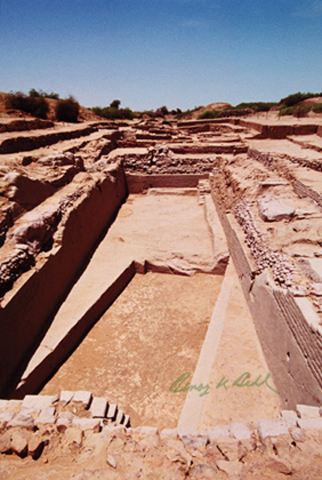Earlier civilisations prospered due to culture of harmony

Dholavira, Gujarat, excavated site of Indus Valley Civilisation. Pic.: Benoy K Behl.
Benoy K Behl
In the fourth millennium BCE, one of the earliest civilisations of the world was developing in the river valleys of the Indian subcontinent. In these fertile valleys, with the growth of agriculture, civilisations prospered. Instead of fighting for survival, people could now begin to improve their lives.
The first sites of this culture were discovered in the basin of the River Indus and consequently the name Indus Valley Civilisation has remained. However, scores of other sites have been found in recent decades spread over a vast area, including coastal Gujarat, Maharashtra and eastwards till Uttar Pradesh. Estimations of the area covered by this civilisation vary from 1.2 million square kilometres to 2.5 million square kilometres. In any case, it was the largest area of any civilisation in the world at that time.
Dholavira in Gujarat is the excavated site of Indus Valley Civilisation. It is in taluka Bhachau in Kutch district. It is surrounded by the salt waste of the Great Rann of Kutch. It had an advanced concept of town planning. Buildings were made of clay bricks and water reservoirs were made of stone
The cities which have been excavated reveal a well-planned grid with broad main roads and smaller lanes, intersecting at right angles, revealing a well-developed and sophisticated concept of town planning. There were large networks of hundreds of wells which supplied water to the residents. A complex drainage system existed and even the smallest houses were connected to it. Houses, some with several storeys, were made of fired-clay bricks. The standardisation of dimensions of these bricks, found in many cities across this civilisation, is remarkable.
Unlike other civilisations in the world of that period and later, excavations across this culture have not revealed evidence that point to the existence of military forces or weaponry for warfare. While the art of other early civilisations such as the Mesopotamian and the Egyptian has many images of prisoners, monuments to war victories and other activities related to warfare, the art of the Indus Valley has not yielded a single such depiction.
It may be noted that excavations have not revealed the remains of any barracks, which are considered essential for the housing of armies or police. Quite remarkably, archaeology has also not found weapons of war at these sites. Whereas the sites of other civilisations have yielded many thousands of weapons of war, the Indus Valley sites have only provided single or very small numbers of blades, which would be expected to be hunting or kitchen implements. (It is true that in 2018, the Archaeological Survey of India found a few copper swords at a burial site at Sinauli in Uttar Pradesh. However, this site is of the 2nd Millennium BCE, late / post Indus Valley period.)
While the above facts are not necessarily conclusive proof that the Indus Valley civilisation was a unique example of a culture which managed without military and police forces, it certainly points towards such a possibility. We may also note that these people were not isolated from the rest of the world, but were in fact trading with other lands.
Even as a possibility, what a remarkable example of peaceful living and harmony emerges from the study of this ancient civilisation. Here were very prosperous people who were technologically advanced for their time and they appear to have lived in great harmony, without finding the necessity to have barracks for police or armies!
In subsequent emails, we will speak more about this great cooperative culture, which seemed to have managed very well without conventional kingship.


